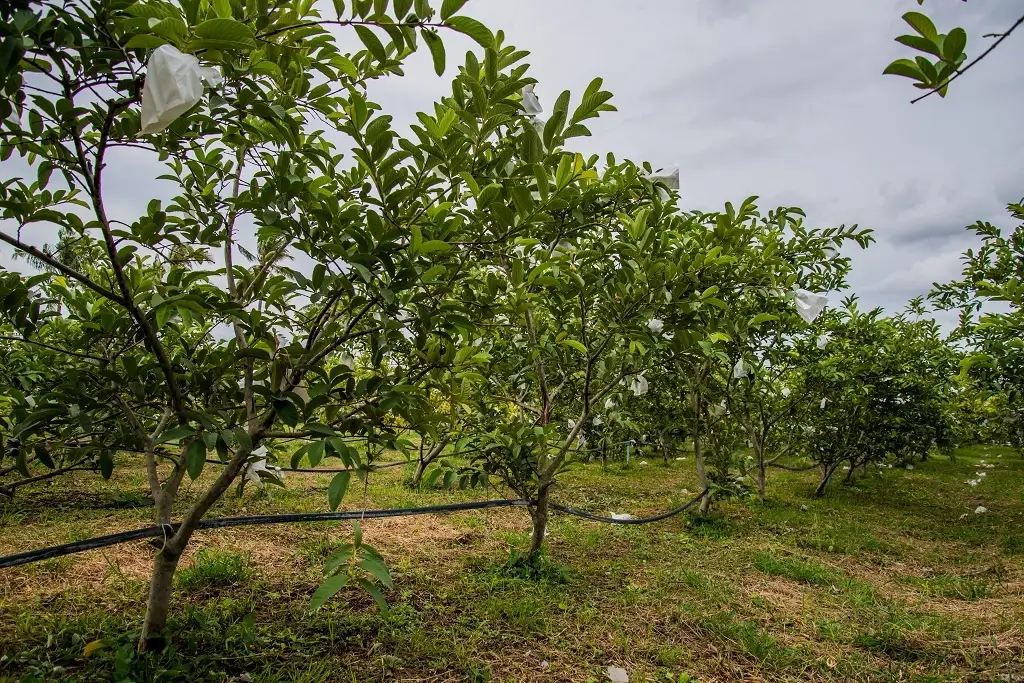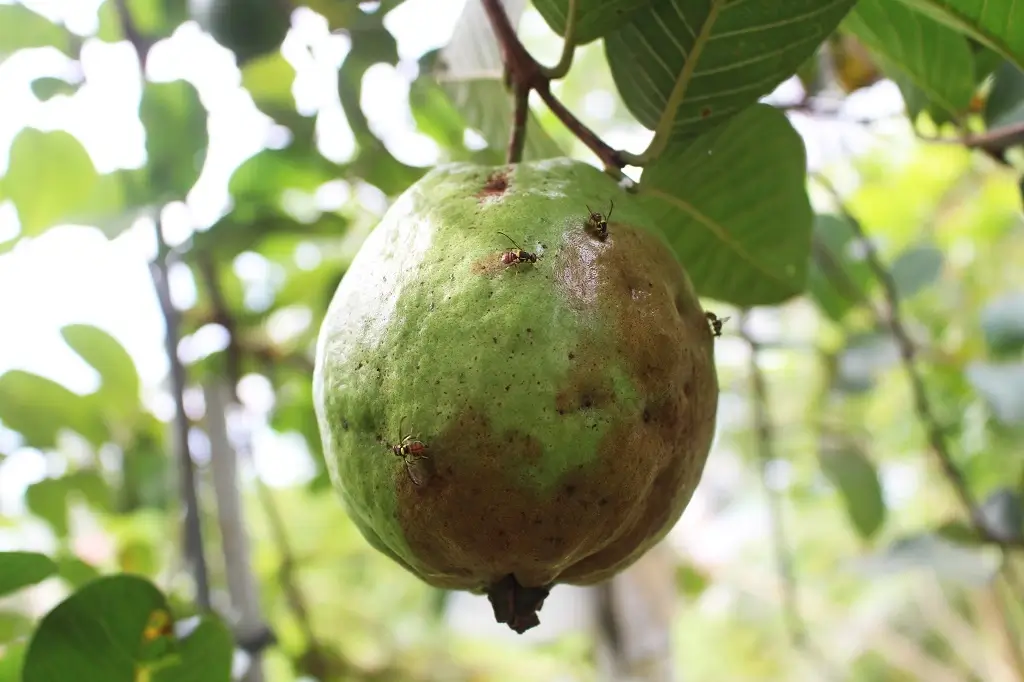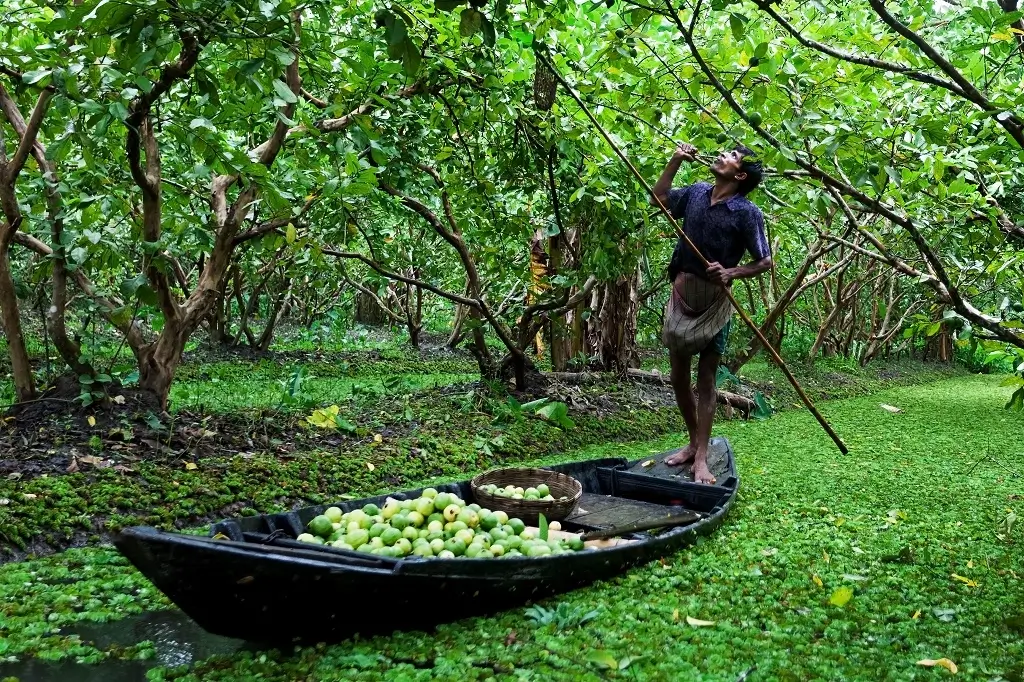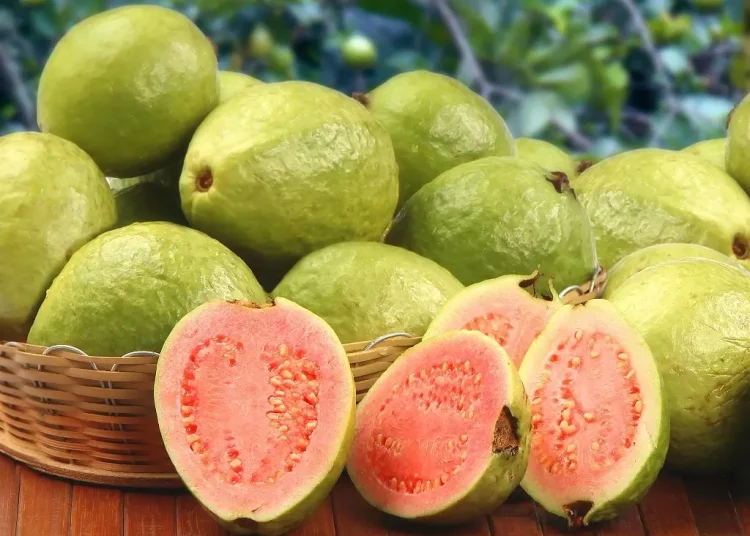Psidium guajava, commonly known as guava or lemon guava, are tropical fruits that are cultivated and enjoyed in tropical and subtropical regions. The fruit is native to Mexico, Central America, and northern South Africa.
They were first adopted in Asia as a crop. This article will help discuss the types of guavas and its benefits. It will also talk about how the fruit taste.
Table of Contents
ToggleThe Taste Of The Fruit
A guava fruit is said to taste like a combination of a pear and a strawberry. They act as a really good thirst quencher. The pulp inside may taste sweet or sour depending on the ripeness of the fruit.
Some sweet varieties are fragrant and taste like grapefruit and pear together. You know you have picked the perfect guava if it releases a strong, sweet, floral and tropical smell when sniffing.
The pulp, rind, and seeds of a guava fruit are also edible. The rind may look inedible. It is actually soft and sour-sweet in taste. The seeds are quite hard and can damage your teeth.
Unlike guavas, the whole fruit of gooseberries is edible.
The term “guava” is derived from Arawak Guayaba or “Guava tree” in Spanish. The term has been adopted in many European and Asian languages. It is called “peru” in the western Indian Ocean and “amrood“, a variant of armoot meaning “pear” in Arabic and Turkish languages.
Types Of Guavas:
- Tropical white
- Tropical pink
- Mexican cream
- Red Malaysian
- Lemon Guava
- The Fruits And Its Characteristics
The Guava fruit is usually 4 to 12 centimeters or 1.6 to 4.7 inches long. They are round or oval depending on the type of guava. They are similar to a lemon rind but are less sharp and have a pronounced and typical fragrance.
The outer skin may be rough and often with a better taste, or it can also be soft and sweet.
The skin can have different thicknesses depending on the type of guava. It is usually green before maturity and will become yellow, maroon, or green when ripe.
The color or pulp inside may be off-white for white guavas or deep pink for red guavas. Depending on the type of guava, the seeds in the pulp vary in number and hardness.
Recommended: Spring into Gardening: How to Start a Garden for Beginners
The Guavas Preference
Location

The guavas prefer frost-free locations and subtropical climates. The plants prefer to be under the heat of the sun. Like all other plants, they require sunlight for food production.
Soil
The soil requirements of the guava plant are wide. They can tolerate different soil conditions. To have better production, it is best to use soils that are rich in organic matter. The guavas prefer soil in pH levels of 5 to 7. It cannot tolerate salty soils.
Irrigation
Guavas do best with deep watering regularly. Although they can survive dry summers without water, it will result in a delay in bloom and will cause the fruit to drop. So, frequent watering is a must to keep guava trees healthy.
Propagation
Guava seeds germinate in about 2 to 3 weeks from planting, although some can take as long as eight weeks. Vegetative propagation is practiced widely. The guava tree can also be grown from root cuttings.
Pests And Diseases

Anthracnose, a foliage disease, can be a problem in some humid climates. It is best to cover the fruit with paper sacks to protect it from scale, whiteflies, and mealy bugs to ensure its high quality.
Harvest

Guavas will ripen all year long in warmer climates. When it is ready to harvest, the fruit will give off a different aroma and change its color. It is best to allow the fruit to ripen on the tree. But they can also be picked and allowed to ripen at room temperature.
Cultivars
These are varieties of guavas that have been produced in cultivation by selective breeding of genes.
In our exploration of diverse fruit origins, we came across the Beaumont fruit, a medium to large roundish delight weighing up to 8 ounces, hailing from Halemanu in Oahu, Hawaii. Similarly, the Detwiler, which has its roots in Riverside, California from the early 1900s, presents itself as a medium to large fruit, roughly 3 inches in diameter.
Not far behind is the Hong Kong Pink, another medium to large roundish fruit tipping the scales between 6 to 8 ounces, a gem discovered at the Poamoho Experimental Farm in Oahu. Venturing south, we find the Mexican Cream, a small to medium-small roundish fruit from the heart of Mexico.
Florida, however, appears to be a hotbed for unique fruits. The Red Indian is a medium-large, roundish fruit with a pronounced odor, indigenous to Dade County. The Ruby X, a hybrid of the state, is a petite roundish specimen.
Moreover, Florida introduces us to the Sweet White Indonesia, a large fruit exceeding 4 inches in diameter, the White Indian which is a small to medium-sized roundish fruit measuring between 2-1/2 to 3 inches, and lastly, the White Seedless, which stands out with its seedless, white flesh of perfect quality.
How Can You Tell When Guava Fruit Is Ripe?
The anticipation of biting into juicy and flavorful guava is a feeling shared by many fruit lovers around the world. Guavas, with their tropical allure, promise a burst of sweet and tart flavors. But how do you ensure you’re getting the best experience with this fruit? It’s all about knowing when it’s ripe.
Checking for Ripeness
- Touch: The first and most intuitive method is to gently squeeze the fruit. A ripe guava will have a softness similar to that of a ripe mango or avocado. Just a gentle press with your fingers will give a slight yield if the guava is at its peak of ripeness.
- Aroma: Bring the fruit close to your nose. A mature guava will release a sweet fragrance that intensifies as it ripens further. If you find yourself being tempted by the scent every time you pass by your kitchen counter, chances are, your guava is ready for consumption.
For those who’ve brought home under-ripe, green guavas, patience is key. Leave them at room temperature to mature naturally. However, if you’re a tad impatient, a tried-and-true trick is to place them in a paper bag with a banana or apple.
This accelerates the ripening process, thanks to the ethylene gas these fruits emit.
Storing Your Guava
After ensuring your Guava has reached its prime, the next challenge is storage. Here’s how:
- Room Temperature: If your Guava hasn’t fully ripened, let it sit on your countertop or in your fruit bowl.
- Refrigeration: Ripe guavas should be nestled in a paper bag and then placed in the crisper section of your refrigerator. They’ll be good for about two days, so try to consume them before they lose their delightful texture and taste.
- Freezing: If you’re thinking long-term, dice your guavas and store them in resealable plastic bags. They can last up to eight months in the freezer. These frozen chunks can jazz up smoothies or be thawed for later use.
The Best Ways To Enjoy Guava
Nutrient Punch: Guavas are nutrition powerhouses. Surprisingly, the guava’s rind boasts more vitamin C than an entire orange!
Savoring the Fruit:
- Guava Spread: Think of a warm toast smeared with guava jam or preserve. The sweetness perfectly complements morning loaves of bread.
- Breakfast Smoothies: For a tropical twist to your morning routine, drop some frozen guava pieces into your blender. It’s a morning treat you won’t want to miss.
- Pastry Fillings: Guava puree finds its place in many pastry kitchens. Its sweet notes make it a perfect pairing with buttery pastries.
- Fruit Salads: Diced Guava combined with other tropical fruits like mango, dragon fruit, and papaya creates a vibrant, flavorful salad. Even common fruits like strawberries and bananas come alive when paired with guava.
- Guava in Green Salads: For a sweet contrast in your green salad, toss in some guava pieces. It balances out the savory elements beautifully.
- Dessert Toppings: Elevate your ice creams and sundaes with fresh guava slices. Top it off with a dollop of whipped cream, and you’ve got yourself a tropical treat.
- Guava Juice: A simple yet satisfying drink made by blending guava with lime juice, sugar, and water. Don’t forget to strain to get a smooth texture.
- Guava Cocktail: Add a twist to your evening with a guava-mint cocktail. Mix guava juice, fresh mint, tequila, and lime juice for a refreshing drink.
- Eat it Raw: Sometimes, simplicity is the best. Wash your guava thoroughly, check for any external blemishes or pests, and take a bite. Experience the unaltered, pure taste of guava.
Remember, whether you’re savoring it on its own or incorporating it into dishes, the key is to ensure it’s ripe. The magic of guava lies in its perfect ripeness, bringing a piece of the tropics right into your hands.
Frequently Asked Questions (FAQs)
How many calories are in a guava?
Medium-sized guava, approximately 55 grams, contains around 37 calories. However, this number can vary based on the specific variety and ripeness of the fruit.
Can guavas help in weight loss?
Yes, guavas are considered beneficial for weight loss due to their high fiber content and low-calorie count. The fiber helps to keep the stomach full for a longer duration, reducing the urge to eat frequently.
Is guava good for diabetes?
Guavas have a low glycemic index (GI) and are rich in dietary fiber, making them a good fruit option for diabetics. They help in controlling blood sugar levels by slowing down sugar absorption in the blood.
Can you eat guava leaves?
Yes, guava leaves are edible and are often used for their medicinal properties. They are brewed to make guava leaf tea, which is believed to have numerous health benefits, including aiding digestion and boosting immunity.
How should you store guavas to ensure they last longer?
Unripe guavas can be stored at room temperature until they ripen. Once ripe, they should be stored in the refrigerator to prolong their freshness. It’s best to consume them within a week for optimal taste and nutrition.
Conclusion
There are different types of guavas found around the world and called by different terms. Guava is a healthy fruit with an above-average national profile. The fruit is a very good thirst quencher. It tastes like a combination of strawberry and a pear. The pulp found inside the fruit may taste sweet or sour depending on the type of guava or the ripeness of the fruit. It is very healthy, so do not hesitate to eat one at every chance you get.



















